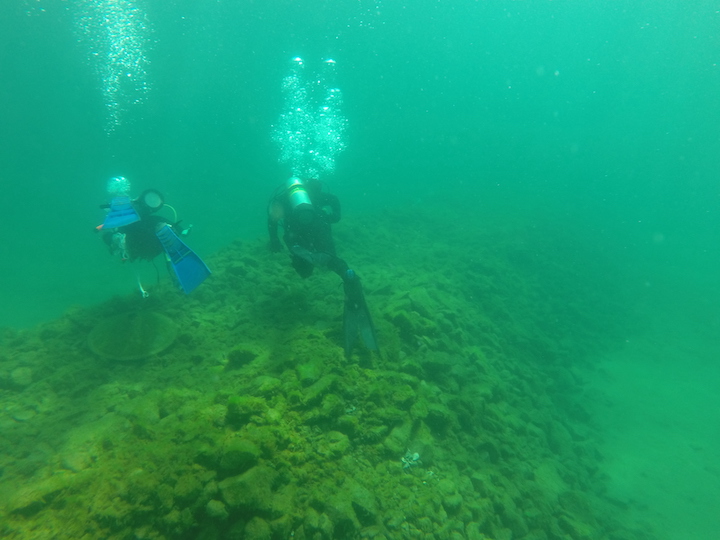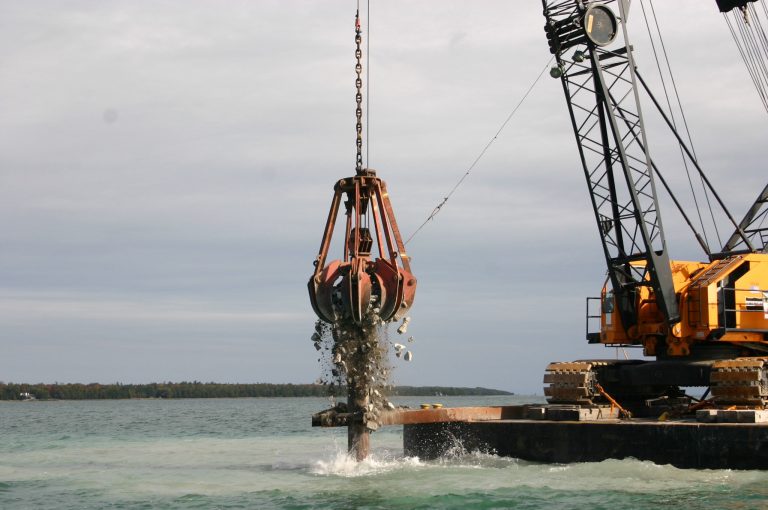
Ellen Marsden
Some organisms taking refuge in artificial cobble reefs in Thunder Bay are invasive, but researchers say they don’t interfere with native species.By DANIEL SCHOENHERR
Capital News Service
LANSING – The ecological success of artificial reefs in Lake Huron’s Thunder Bay could teach people how to restore fish populations across the world.
Ellen Marsden, a fisheries and wildlife expert from the University of Vermont, spearheaded the construction of 29 reefs built with small stones – cobble aggregate – in Thunder Bay in 2010.
“The goal was to create a space for baby trout,” Marsden said.
Marsden evaluated natural and constructed Thunder Bay reefs over 10 years and discovered that the reefs were a success.
The constructed reefs are likely to be adequate for fish to breed and reproduce indefinitely, her study showed. The number of trout eggs found at each location indicated fish used the artificial reefs just as much as natural reefs.
A difficult part of the study was monitoring how many eggs were laid during winter spawning.
“The water is freezing cold. You just have a job to do,” said Stephanie Gandulla, a diver with the Thunder Bay National Marine Sanctuary in Alpena who helped collect data for the study.
Human activity and boat traffic in the Great Lakes stir up sediments that can deposit on natural reefs and leave fish without places to lay their eggs. Many spawning sites have disappeared in Lake Huron over the past century, leading to the disappearance of fish such as lake trout, Marsden said.
“We know Lake Huron historically had many spawning sites,” said Ji Xiang He, a fisheries research biologist at the Alpena Fisheries Research Station.
Today, human-made hatcheries support dwindling lake trout in Lake Huron.
Hatcheries stocked 1 million to 1.5 million lake trout in the lake each year until 2018, Ji said. Loss of funding led to less stocking, and surveys show wild lake trout spawning didn’t compensate for the decline.
Artificial reefs have been used in the United States to lure fish since the 1830s, when logs were thrown into the water off the coast of North Carolina to help with fishing. Today, organizations use ferries, tires and even football stadiums to create reefs.
Constructed reefs can benefit aquatic life but they need to be done responsibly, Marsden said.
Materials such as concrete and rubber contain toxic components that can pollute water for decades, Marsden said.
For example, poorly designed reefs can also damage surrounding habitats. After a reef consisting of over 2 million tires off the coast of Fort Lauderdale was completed, the tires began to move around and destroy nearby coral reefs.
Marsden often tells companies that it’s unrealistic to create reefs out of their products.
Schwinn officials once asked her if they could construct a reef from their extra bikes. She told them that the cost of cleaning the bikes would be more than buying safe materials.
“We’re already seeing artificial reefs across the world,” Marsden said. “Now we just need to make it more of a science.”
One project using unconventional material that got Marsden’s approval came from a man who proposed to sink a decommissioned ferry in Lake Champlain.
Jonathan Eddy, the owner of the Waterfront Diving Center in Burlington, Vermont, made sure complex machinery and oils were removed from the vessel first and that its location on the lakebed didn’t interfere with pre-existing habitats.
Marsden supported the project, writing to Eddy that “the ferry could also be a site of several short- or long-term research projects.”
Few freshwater shipwrecks are easily accessible for research, and little is known of how fish use them.
Despite Eddy’s efforts, a lawsuit by a conservation group stopped the project, claiming the sinking of the ferry was motivated by greed and posed significant danger to the lake’s wildlife.
“The fact this didn’t come to fruition drove me absolutely insane,” Eddy said. “It was the right thing to do to preserve history.”
Structures like breakwalls can damage natural reefs, but they show off the potential of artificial ones. “Who knew the Army Corp of Engineers were great at designing reefs?” Marsden said.
Engineers made each reef monitored in the study with a different size, position and edges to test what trout preferred, Marsden said. “I saw it and thought, ‘Wow, that’s exactly what was in my drawings.’”
While the study shows the trout are using the reefs in Thunder Bay, only time will tell if the numbers will recover.
Ji said, “Even with rebuilding the lake trout population, it could take a long, long time for lake trout to find the adequate reef to reproduce.”
Marsden agrees: “Patience is often the key.”
Daniel Schoenherr writes for Great Lakes Echo

Ellen Marsden
Thunder Bay’s cobble reefs are a tourist attraction and hot fishing spot.